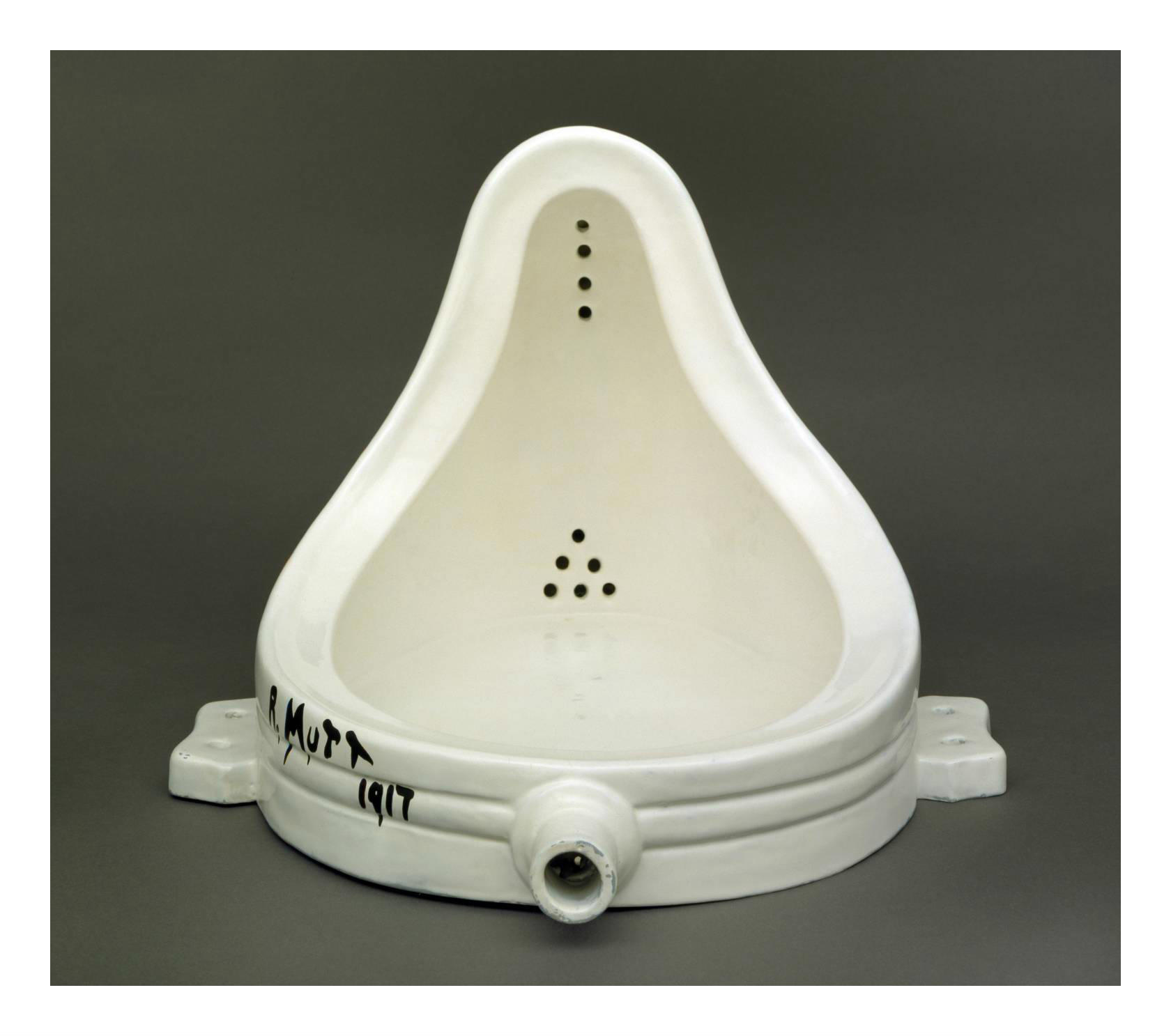You have no items in your cart. Want to get some nice things?
Go shopping
John Higgs presents “The Urinal and the Baroness”
Shakespeare knew the potential dramatic consequences of an idea set forth into the world. In Twelfth Night the unfortunate Malvolio falls victim to a cruel prank that plants an idea in his head which he then develops and gets carried away with, resulting in his own humiliation and madness. It is because such ideas have no owner or stable origin that the outcomes prove so volatile. In the right circumstances ideas develop and break new ground, providing new perspectives. But added to the wrong cocktail of cause and consequence and there is trouble afoot.
This is one of those truths that has outlived Shakespeare’s time. At the beginning of the twentieth century the psyche of culture had been shocked into new perspectives, torn apart by war, industry and technology. Modernism was an idea that encompassed many which shot up like weeds from the broken ground. From the edges of these ideas there were cracks from which more defiant voices could be heard, creating their own shockwaves.
This is the frame which sets the scene for John Higgs’ talk on Marcel Duchamp and the mysterious origins of his urinal; the notorious “Fountain”, of course. A crowd has assembled in the modest marquee that is the Odditorium stage at Wilderness on this sunny Sunday afternoon. “Oh, you’re in for a treat,” Higgs enthused to us. He was right. He relished in the fact that nobody in the audience had ever heard about the Baroness Elsa von Freytag-Loringhoven. The story of her life and art (utterly indistinguishable from one another as we would discover) is a mind-expanding one, and very appropriate for the Odditorium stage.
As conceptual art was beginning to challenge the artwork’s status as an object, and the subject’s relationship to it, in a world where women were often considered the object rather than the creator of ground-breaking art, Baroness Elsa declared “I am the artist!” John Higgs describes her as “the first American New York punk” on the art scene. In the early 1900s she would arrive at private views dressed in old tin cans and stuffed parrots, produced bizarre and at times obscene poetry, and presented a plumber’s trap for an exhibition and called it “God”. How do we account for this chaos incarnate? A woman torn from her homeland and thrown into the city of new beginnings, life as society dictated it no longer bared relevance to her existence and, without the trappings of a historical lineage, her whole life became matter for her imagination. The sacred and the profane were indistinct concepts for Baroness Elsa, as were any other distinctions defined by a culture that she lived on the outside of, as an orphan and an immigrant.
At some point along the way she met Marcel Duchamp, and the Baroness became besotted, despite the fact that she could not have been considered more different to the intellectual chess player (for a time he stopped calling himself an artist and wished to be known only as a chess player). While it was Duchamp who, as history dictates it, presented an upturned urinal signed “R.Mutt” on a plinth in an art gallery, subsequently establishing conceptual art, it was not until the 1960s that his Readymades (of which Fountain was his first) developed serious critical attention and respect from artists and the art establishment. However, so goes the argument, an actual character evaluation of Duchamp would belie the fact that he was so daring as to produce a urinal for exhibition. This kind of reckless and bold statement seems far more characteristic of the work of the unmistakable Baroness Elsa von Freytag-Loringhoven.
Art historians and academics discovered a personal letter, which surfaced after Duchamp’s death. Dated 1917, in this letter Duchamp wrote to his sister, recalling that “one of my female friends under a masculine pseudonym, Richard Mutt, sent in a porcelain urinal as a sculpture”. The advocates for the Baroness (including John Higgs) have contributed to the recovery and appreciation of this artist and her work, throwing the credibility of Duchamp as the originator of conceptual art into question. However, Higgs is sympathetic to Duchamp, and considers that it could be possible for him to have forgotten who actually presented him with the urinal back in 1917. Subsequently he maintains that the fountain’s true originator remains shrouded in mystery.
That it remains a mystery makes it appropriate for inclusion in Higgs’ forthcoming book, Stranger Than We Can Imagine: Making Sense of the Twentieth Century, which his talk is in essence about. He argues that the pheonomena which defined the late-modern period of the twentieth century cannot be explained from a traditional singular point of reference, known as “the wise man view of history”. In the present era defined as postmodern, where there are no more heroes and big ideas have long been shot through with holes, his approach for this book is what has been described as “the strange person view of history”. While Higgs argues that we should resist trying to “understand” history in the traditional sense, the story of Baroness Elsa is a prism from which shafts of light can be scattered onto this murky and complex period.
“The internet will destroy us”
Responding to a question of who he thought are the “strange people” defining our current century, John Higgs responded that he thought the strangest and most significant things happening in the twenty-first century are coming from collectives, rather than individuals. He gave the example of Anonymous, the hacktivist group, as a group defining the present era. It’s a compelling thought, that the twentieth century was the era of the individual, but the twenty-first century will be known as the era of the collective. I am pretty sure it is more complicated than that though: it comes down to how and under what circumstances these collective movements are formed.
By coming together as a collective human beings can achieve great things, but it can also lead to disaster. The history of revolutions demonstrates that radical ideas, once they take hold and spread among a population, can get out of control and develop lives of their ow. Just imagine, for example, the damage that the scheming Maria could have done to Malvolio had she had the Internet at her service? There was a warning to be heeded from the second presentation of the afternoon in the Odditorium on Internet forums, presented by James Burt. His argument was intended to provoke: “the Internet will destroy us”.
Burt was here to talk about Lolcats (“I can has cheezburger?”) and Doge (actually difficult to talk about because nobody knows exactly how to pronounce it: it exists as language developed from the mute lexicon of the Internet). He also ran through Ceiling Cat (he’s watching you), Charlie Charlie (Mexican demon), Candle Cove (never a real television show), Jeff the Killer (Photoshopped photo-cum-horror legend) and Slender Man (mystery gangly man-shaped shadow said to lurk in photos). Besides Lolcats (because I am a human being who works in an office) all these phenomena were new foreign concepts to me. Not anymore, for I have been educated. Unless you use web forums like 4chan, Reddit and creepypasta, they may be unknown to you as well. If you don’t know them you can Google them and educate yourself – but do so at your own risk, reader!
Burt’s talk was quite a rip-roaring and mind-expanding review of the web of ideas circulating on the Internet, all demonstrating how once an idea loses its origin the imagination takes over with inconceivable consequences. While the Internet functions as the technological conduit for the proliferation of these ideas in the twenty-first century, this fundamental truth about the circulation of ideas among humans has historical precedence everywhere. Like Baroness Elsa von Freytag-Loringhoven, who dubbed a plumber’s trap “God” in an art gallery, the purveyors of Ceiling Cat parade this picture on the Internet as a symbol of divine presence (it’s pretty funny, by the way). In 1938, Orson Welles’s radio broadcast of War of the Worlds was said to have convinced many listeners that aliens were actually invading. While today we may smirk at such naivety (and apparently the reported hysteria the programme caused was itself a myth), this is essentially what the creator of the fake chat forum that started the Candle Cove myth managed to achieve on creepypasta.
Burt draws connections between the myth of the Slender Man and the ancient Tibetan doctrine of the tulpa (which itself has sparked an Internet phenomenon – there are no bounds for these things it seems!). This doctrine insists that it is entirely possible to imagine something into existence, from nothing. Collectively people were writing on the Internet about the existence of the Slender Man until a group of people became so freaked out that he was actually real that they then began collectively writing his own demise, or mocking him in order to “tame” him in some way. This is the folklore of our times, it would seem.
All these examples may seem pretty benign, even cute, so why the warning that “the Internet will destroy us”? When the Lumière brothers created the first publicly shown moving-image film of a railway station in Provence little did they know they had inadvertently created the first horror film. It is said that as the audiences in Paris watched the train chug toward the screen they ran out screaming, convinced the train was about to crash out of the frame and into the auditorium. Whether this is true or another myth like the War of the Words story, it does demonstrate the power film can wield over its audience. The very real unfolding story of the “Slender Man Girls” (who at 13 years old are to be tried as adults in a Wisconsin court for murders committed because they believed the Slender Man told them to) reveals the dangerous power the Internet can and does wield over people today.
The kind of dares that people (children and adults) may make among groups in the playground or in the office now happen on the Internet. The “Ice Bucket Challenge” may have been a harmless and effective fundraising idea but “NekNominations” have wound up killing people. Such ideas become dangerous when the link between cause and consequence becomes loosened, and the Internet exacerbates this danger because it also blurs the distinction between self and other in the real world. Open up any newspaper (or, if that is too quaint an idea, a browser) and you are likely to find examples of how the Internet and mobile apps have lead to sexual harassment and the incitement of racial hatred, as these technologies have on some level made permissible behaviour otherwise legally prohibited in public places. Governments are faced with revising legal frameworks and there are calls for corporations to take their share of responsibility
Whether or not it is considered permissible, it is still far too easy for people to avoid accountability for the consequences of their ideas once they are spread on the Internet. In Twelfth Night Maria did not know what level of madness Malvolio might fall to on account of a fake letter she sneaked into his possession. Whoever had the original idea of Slender Man, could they have known it could have compelled two thirteen-year-old girls to commit murder in Wisconsin? One thing feels certain, as I leave the Odditorium: while the Internet is a conduit, it is ideas that can destroy us, but surely they can be the making of us as well?

About Becky Ayre
Becky is a writer, editor and researcher of visual arts and the environment. She lives in Oxford. She works collaboratively with Inheritance Projects—a small group of independent curators and researchers that organise exhibitions, events, new commissions, publications and research projects. She blogs at Atmospheres of Uncertainty.




